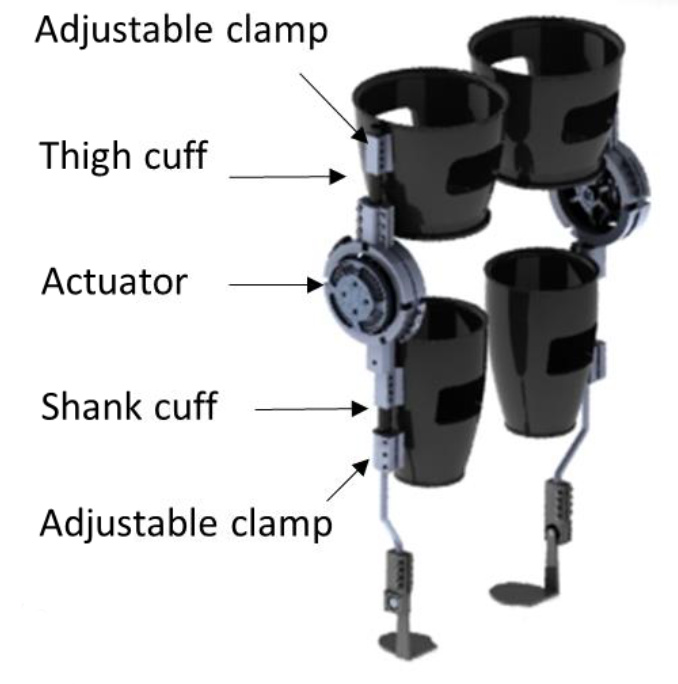This low-cost powered knee exoskeleton provides both knee flexion and extension to augment and aid mobility and rehabilitation. With highly adjustable sizing based on the length of the user’s leg, the device can be used for a wide range of age groups, potentially filling a critical unmet need in the market for a pediatric knee exoskeleton. Parts for the exoskeleton total only about $1,500 (compared with upwards of $80,000 for others on the market), positioning this system from Georgia Tech as an economical choice for rehabilitation in both clinical and home-based settings.
The exoskeleton provides powered mobility assistance to the user’s knee joint while in motion. Up to 17.4 Nm of output torque from a brushless motor is powered by a portable lithium polymer (LiPo) battery. The torque is transmitted to the user’s leg through the thigh and shank orthotic shells and rotates the knee joint. An actuator composed of a single-stage gearhead with a 6:1 ratio enables back driving of the mechanical system with very low effort, which improves safety and reduces battery consumption. The system also provides inputs from mechanical and electrical sensors to capture information about a user’s gait and muscle activity in real time, enabling smart control of the device.
- Lightweight: Uses one of the lightest available electromechanical actuators—just 0.5 kg—along with a mere 1.5 kg for the exoskeleton assembly
- Back-drivable: Lowers the mechanical effort involved in back driving with a single-stage actuator
- Efficient: Reduces battery consumption compared with existing systems
- Adjustable: Fits both adults and children with size adjustments based on the user’s leg length
- Effective: Provides a new and powerful therapeutic tool that should help to improve rehabilitation outcomes safely and efficiently
- Affordable: Offers a low-cost solution with parts totaling only about $1,500, compared with $80,000 to $100,000 for other available devices
Georgia Tech’s knee exoskeleton can be used in both adults and children for mobility assistance, injury rehabilitation, and performance for healthy individuals and athletes in:
- Physical therapy clinics
- Rehabilitation clinics
- Sports medicine clinics
- Pediatric practices
- Occupational therapy clinics
- Professional sports training programs
- Gyms and athletic facilities
- Warehouses and industrial workspaces requiring repetitive squatting and knee flexion/extension in the course of daily work
- The consumer’s home
Current FDA-approved powered exoskeletons for knee-joint mobility and rehabilitation leave much room for improvement in terms of financial accessibility, usability, safety, and efficiency. Available systems have complicated, multi-joint designs that make operation power intensive and require a significant amount of mechanical effort for back driving. Their heavy, bulky assemblies can further tax power consumption and also make the user experience awkward and uncomfortable. These systems also come at a high price tag—between about $80,000 and $100,000—making them extremely costly investments for clinics and cost prohibitive for most individual use. Finally, these systems do not typically accommodate young patients, leaving an unmet need for a pediatric exoskeleton.
Georgia Tech’s device provides advancements in all areas. It is an extremely lightweight, low profile system with smart controls, featuring a single-stage gearhead for high back drivability, lower power consumption and improved safety—all in a highly adjustable package with components that total only about $1,500.

Georgia Tech’s powered bilateral knee exoskeleton features a lightweight, low-cost, low-profile assembly weighing only 1.5 kg and a single-stage actuator for high back drivability.
